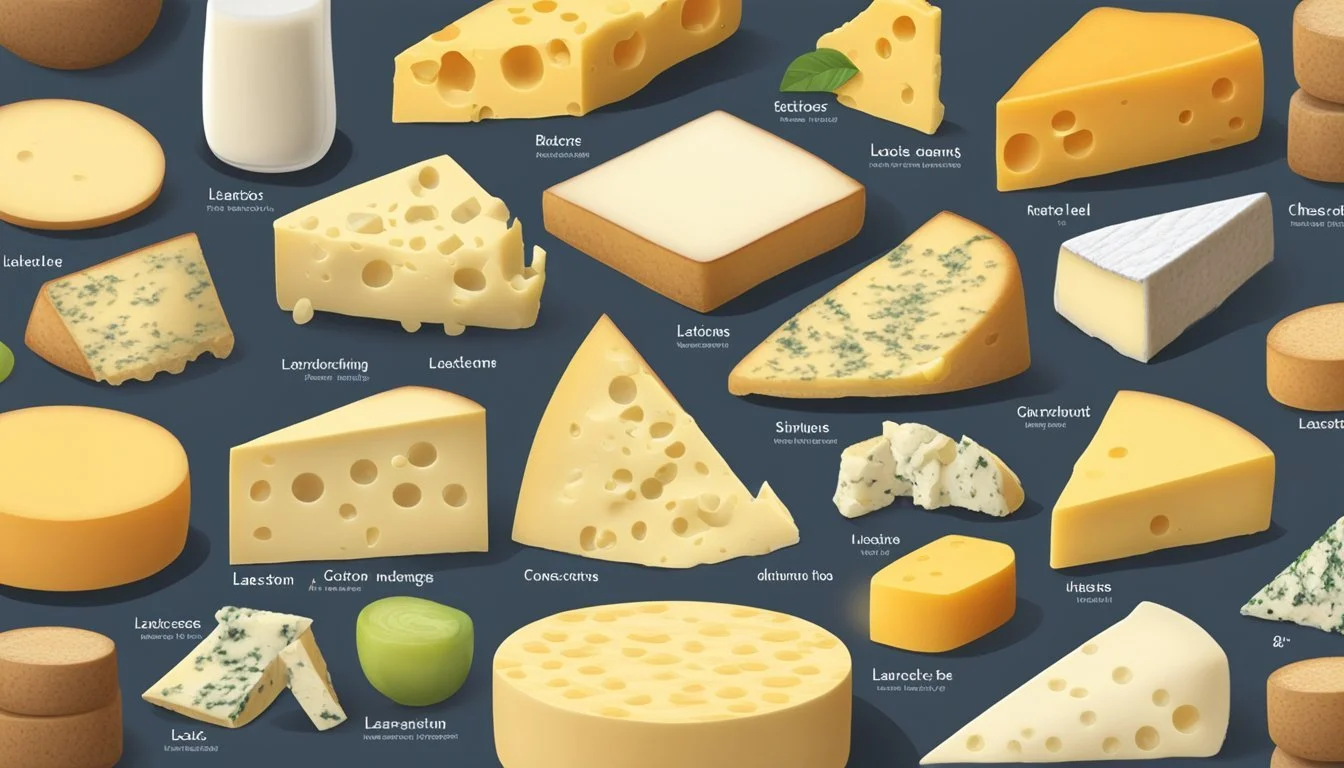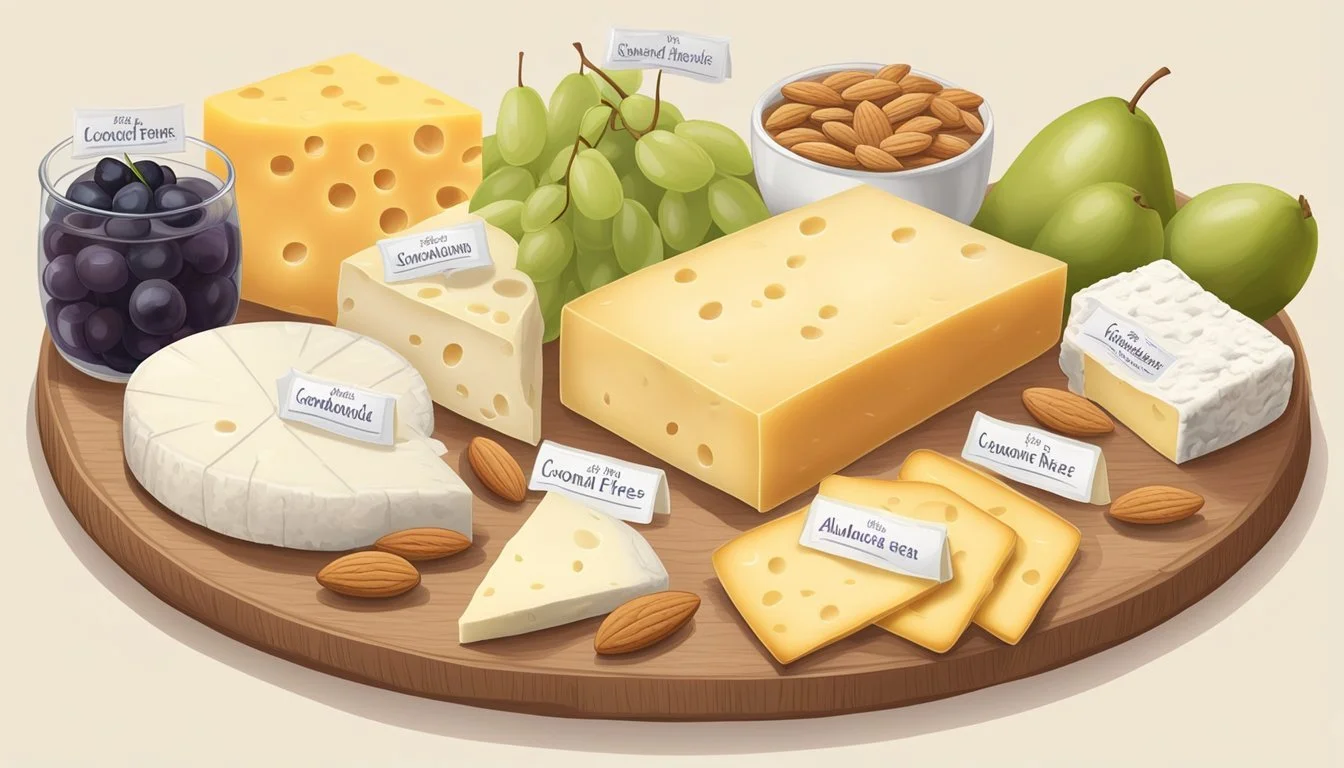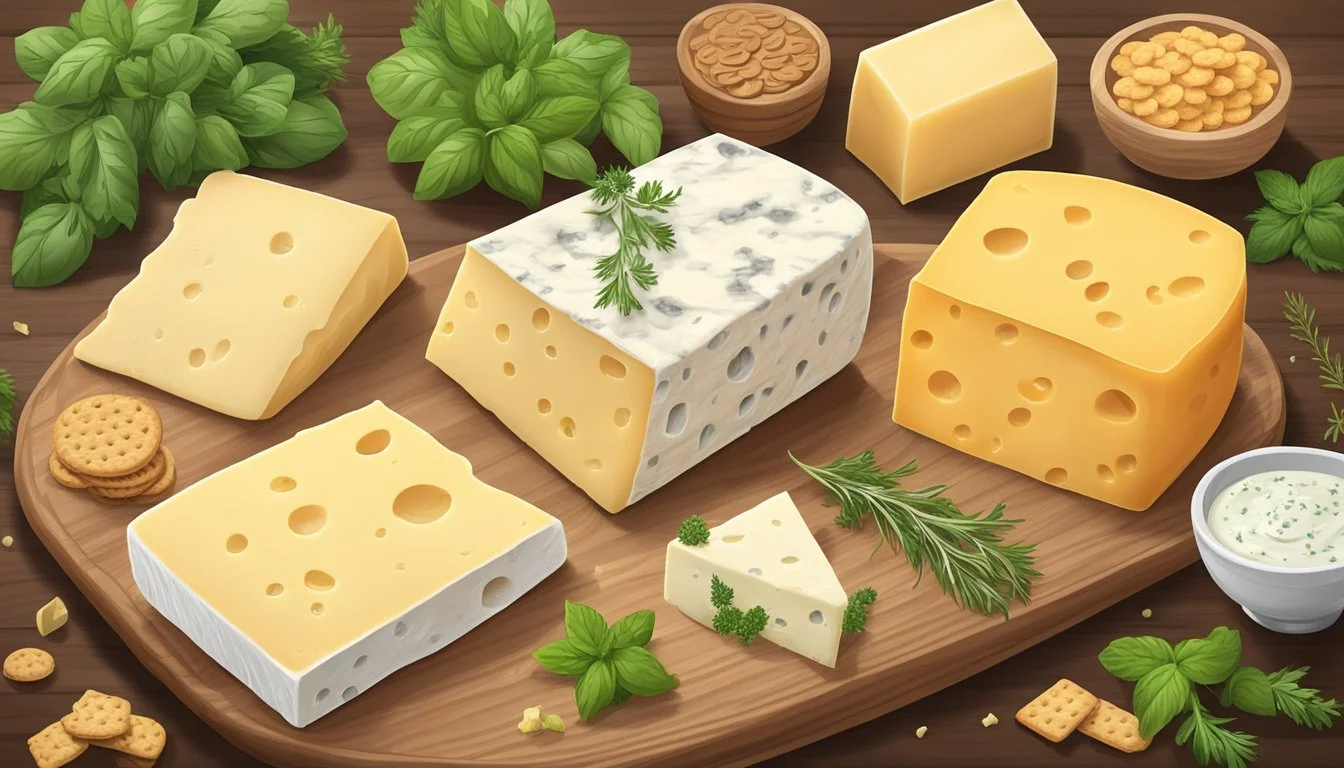What Are Some Lactose-Free Cheese Options?
Exploring Dairy Alternatives for the Lactose Intolerant
Lactose intolerance affects a significant portion of the population, compelling individuals to seek alternatives to traditional dairy products. Lactose-free cheese has emerged as a viable option, allowing people who are lactose intolerant to enjoy cheese without discomfort. These cheeses are crafted using various dairy-free alternatives, such as nuts, soy, and root vegetables, to simulate the taste and texture of their lactose-containing counterparts.
The marketplace offers an assortment of lactose-free cheese brands and types, including those from Treeline, Violife, and Daiya, which cater to those with dietary restrictions. These products typically exclude lactose by incorporating plant-based ingredients and are designed to be easy to digest. Camembert, a cheese that naturally falls in the 0 to 1.8 percent lactose range, is another option for those with a tolerance for minimal lactose.
They're suitable not only for lactose-intolerant consumers but also for vegans and others following dairy-free diets. It is worth noting that while some individuals can tolerate certain low-lactose cheeses, others might need to seek out strictly lactose-free options. The diversity in flavors and textures available means that there is a wide range of choices for those looking to avoid lactose in their diet.
Understanding Lactose Intolerance
Lactose intolerance is a common digestive problem where the body is unable to digest lactose, leading to symptoms such as bloating and discomfort. This section will outline what it means to be lactose intolerant and describe the causes and symptoms of the condition.
Defining Lactose Intolerance
Lactose intolerance occurs when an individual's intestine produces low levels of lactase, the enzyme responsible for breaking down lactose into glucose and galactose, which are simpler sugars that can be absorbed into the bloodstream. Lactose is a disaccharide sugar found in milk and dairy products. Lactase deficiency leads to lactose remaining in the digestive system, where it gets fermented by bacteria, causing symptoms like gas, bloating, and abdominal discomfort.
Causes and Symptoms
The causes of lactose intolerance can be genetic or due to certain gastrointestinal diseases or injuries to the small intestine. It may also develop with age, as the body naturally starts to produce less lactase after infancy.
The symptoms vary widely among individuals and typically include:
Bloating
Gas
Abdominal pain
Diarrhea
These symptoms can range from mild to severe, based on the amount of lactose ingested and the degree of lactase deficiency an individual has. The discomfort typically begins within a few hours after consuming lactose-containing foods or beverages. It is important for those who suspect they may be lactose intolerant to consult with a healthcare professional for appropriate diagnosis and management.
The Science of Cheese Making
Cheese making involves a delicate interplay between fermentation, the aging process, and the lactose content, all of which contribute to the final taste, texture, and digestibility of the product.
Lactose in Cheese Production
During cheese production, lactose is the sugar present in milk that is utilized by bacteria to create lactic acid through fermentation. This acidification process causes the milk proteins to coagulate, forming a solid mass called curd. The curd separates from the liquid, known as whey, which contains most of the lactose. Consequently, as the whey is drained away, so is a significant portion of the lactose.
Role of Aging in Lactose Content
The aging process further reduces the lactose content in cheese. Over time, the remaining lactose is gradually converted into lactic acid by bacteria. Therefore, aged cheeses like cheddar, Parmesan, and Gouda typically contain less lactose. For instance, Gouda aged for 18 months or longer can be virtually lactose-free. The general rule of thumb is: the longer the cheese ages, the less lactose it contains, which is beneficial for those with lactose intolerance.
Lactose Levels in Cheese Types
Various cheeses contain different lactose levels, with aged cheeses typically having lower lactose content, soft cheeses varying greatly, and fresh cheeses generally being higher in lactose.
Aged Cheeses
Aged cheeses are notable for their lower lactose content due to the longer fermentation process which reduces lactose. Cheddar, for example, is a type of aged cheese that usually contains about 0.4 to 0.6 grams of lactose per ounce. Similarly, Gouda is another aged cheese with lactose levels ranging from 0.0 to 2.2%, making them both viable options for those with lactose intolerance.
Soft Cheeses
Soft cheeses have inconsistent lactose levels but can be low if aged sufficiently. Brie and Camembert are soft cheeses that, when matured for at least four weeks, can contain less than 1 mg/100 g of lactose. This makes them relatively safe choices for people with sensitivities. On the other hand, cheeses in this category that are not adequately matured may have higher lactose content and should be consumed cautiously.
Fresh Cheeses
Fresh cheeses are typically higher in lactose and may not be suitable for lactose-intolerant individuals. These cheeses have not undergone a significant aging process, which means the lactose remains present. Options such as cottage cheese, ricotta, and mozzarella often contain more lactose and should be approached with caution or avoided by those with intolerance.
Popular Lactose-Free Cheese Options
For those seeking dairy delight without the lactose, a variety of cheese types fit the bill. From hard-aged selections to innovative plant-based creations, lactose-free options abound, providing the rich flavors and textures cheese lovers crave.
Hard Cheeses
Hard cheeses, such as Parmesan and aged Cheddar, often have negligible lactose content due to their longer fermentation processes. The aging reduces the lactose, rendering these cheeses friendlier to those with sensitivities. They are well-suited for grating over dishes or enjoying as part of a cheese platter.
Parmesan: Virtually lactose-free with a hard, granular texture.
Aged Cheddar: Typically aged for several months to years, reducing lactose content.
Aged Cheeses with Minimal Lactose
Cheeses like aged Swiss and Manchego have very low lactose levels as the majority is lost during the cheese-making and aging process. Similarly, Pecorino, made from sheep's milk, offers a rich flavor and is also low in lactose, given its aging process.
Swiss Cheese: Aged versions have trace lactose amounts.
Pecorino: Sheeps' milk cheese that is naturally lower in lactose.
Manchego: A Spanish cheese with minimal lactose when aged.
Vegetable-Based Cheeses
For a completely dairy-free option, cheeses made from vegetable sources like nuts and root vegetables are available. Brands like Treeline, Violife, and Daiya offer a variety of vegan cheeses. These products are crafted from ingredients such as soy, almonds, and tapioca, suited for both lactose intolerance and vegan preferences.
Treeline and Violife: Offer cheese alternatives made from cashews and other plant-based ingredients.
Daiya: Known for its range of dairy-free cheese styles using tapioca-based formulations.
With these lactose-free cheese options, individuals with lactose intolerance or dairy sensitivities do not have to sacrifice the joy of eating cheese, whether they prefer the sharpness of aged cheese or the plant-based varieties that mimic traditional cheese flavors and textures.
Cheese Alternatives for Lactose Intolerant Individuals
For individuals with lactose intolerance, enjoying cheese requires exploring alternative options that do not contain lactose. These alternatives come in various forms, from plant-based products to homemade recipes that avoid the use of traditional dairy.
Plant-Based Cheese Alternatives
Plant-based cheeses offer a diverse range of flavors and textures suitable for lactose-intolerant diets. They are commonly made from ingredients like soy, nuts, and rice, which are naturally lactose-free. Vegan cheeses have seen significant improvements in taste and meltability, making them a popular choice for those avoiding dairy. Some notable plant-based cheese alternatives are:
Soy-based cheeses: They replicate the texture of traditional cheese and are a good source of protein.
Nut-based cheeses: Often made from almonds or cashews, these cheeses are known for their rich and creamy consistency. Cashew cheese, in particular, is praised for its smooth texture and versatility in recipes.
Rice-based cheeses: Lighter in texture, they are ideal for those who prefer a milder flavor.
These dairy-free cheeses can be found in health food stores and well-stocked grocery stores, catering to a variety of dietary preferences and uses, from spreading on crackers to melting in sandwiches.
DIY Lactose-Free Cheese Recipes
For those who prefer homemade options, DIY lactose-free cheese recipes provide an opportunity to create custom flavors and textures. While these recipes may not perfectly mimic the characteristics of traditional cheese, they offer a satisfying alternative for those with lactose intolerance. Some recipes include:
Cashew-nut spread: Blend soaked cashews with nutritional yeast, lemon juice, and spices to achieve a cheese-like spread.
Vegan ricotta: Combine blanched almonds or tofu with lemon juice and seasoning for a dairy-free take on the classic Italian cheese.
Creating lactose-free cheese at home allows individuals to control the ingredients, ensuring that nothing triggers lactose intolerance while still enjoying the essence of cheese.
Incorporating Lactose-Free Cheeses into Your Diet
Lactose-free cheeses offer a solution for those looking to enjoy the taste and versatility of cheese without the digestive consequences. These cheeses can be used in a range of dishes, from simple snacks to complex entrees, providing taste and texture comparable to traditional cheeses.
Cooking and Baking with Lactose-Free Cheese
Lactose-free cheese can be utilized in cooking and baking much like traditional cheese. When creating pizzas and casseroles, one can substitute lactose-free cheese directly for its lactose-containing counterparts. They melt well and add the desired creamy texture to these dishes. For example, in a casserole, a serving size of about 1/2 a cup can deliver both flavor and cohesiveness without any lactose issues.
When preparing grilled cheese sandwiches, lactose-free cheese slices can offer the same gooey satisfaction as regular cheese. They can easily become part of a wrap or be layered within sandwiches for added flavor without digestive discomfort.
Pairing and Serving Suggestions
Cheese platters are where lactose-free cheeses truly shine. To build an appealing platter, select a variety of lactose-free cheeses, ranging from soft to hard textures. Complement these with fruits, nuts, and gluten-free crackers to cater to those with dietary restrictions.
Lactose-free cheeses also elevate salads, bringing in rich flavors and textures. A simple, yet effective way to introduce lactose-free cheese into any diet is to sprinkle crumbled or shredded variants onto salads, just as one would with traditional cheese. Keep in mind that a small serving size like a tablespoon can be sufficient for enhancing a salad.
Remember, when incorporating lactose-free cheese, the key is to experiment with amounts and types in different kinds of meals until one finds the perfect balance that suits both taste and dietary needs.
Shopping and Label Reading Tips
When purchasing cheese, consumers should pay close attention to labels and understand them comprehensively. Lactose content is a critical factor for lactose-intolerant individuals, and knowing which types of cheese are likely to have lower lactose can make shopping easier.
Understanding Cheese Labels
Labels on cheese products provide essential information about lactose content. Cheeses that are aged longer tend to have less lactose since the lactose is broken down during the aging process. When scanning a label, one should look for terms such as "lactose-free" or specific mentions of the lactase enzyme, indicating that the product is suitable for those with lactose intolerance.
Furthermore, labels often include a nutritional facts table where sugar content can provide clues about lactose levels, as lactose is a sugar. Lower sugar content generally means less lactose. A cheese's fat content is another indicator, with higher-fat cheeses typically containing less lactose.
Recognizing Hidden Lactose
Despite clear labeling, some cheeses might contain hidden lactose. It is important for shoppers to be aware of terms that may indicate the presence of lactose. For example, "dairy-free" does not necessarily mean lactose-free, as the product might still contain lactose-derived ingredients.
Here are some terms that may suggest a cheese has lactose:
Whey
Milk solids
Curds
Milk by-products
In addition to identifying these terms, consumers should also look for explicit mentions of "lactose-free" on packaging and ingredients lists. Cheeses made from non-dairy alternatives, including soy, nuts, or root vegetables, are typically free from lactose and suitable for those avoiding lactose.
Health Considerations and Nutrition
When considering lactose-free cheeses, one should be aware of both their nutritional content and the impact on digestive health. These cheeses provide alternatives for lactose intolerant individuals and can contribute beneficially to a balanced diet.
Nutritional Profile of Lactose-Free Cheese
Lactose-free cheese typically contains comparable amounts of protein and fat to their lactose-containing counterparts. Nonetheless, the absence of lactose does not significantly impact the overall caloric content. For those who are lactose intolerant, hard cheeses such as aged cheddar or Swiss have negligible amounts of lactose, and their aging process allows beneficial bacteria to predigest most of the lactose content. Here's a general outline of the nutritional content in several lactose-free cheeses:
Calcium: Crucial for bone health, available in most cheese.
Protein: Essential for muscle repair and growth, present in high quantities.
Fat: Varies from cheese to cheese, with some having reduced-fat options.
Managing Digestive Health
For individuals with lactose intolerance, choosing lactose-free cheese options can prevent symptoms such as bloating and cramping. Since lactose is the primary sugar in milk that causes these digestive issues, lactose-free cheese is an excellent alternative. Consuming them ensures that an individual's diet remains rich in dairy nutrients without the uncomfortable side effects. Some enzymes found in these cheeses can even aid in digestion and overall gut health.
Global Lactose-Free Cheeses
Lactose-free cheese options are diverse, spanning various regions and catering to both traditional dairy and vegan preferences.
Cheeses from Around the World
In France, Brie and Camembert are notable for their very low lactose levels, often containing less than 1 mg/100 g of lactose after maturing for four weeks. These soft white mould cheeses provide the creamy texture and depth of flavor that cheese connoisseurs appreciate, without discomfort for those with lactose intolerance.
From the Netherlands, Dutch Gouda is another cheese that is well-regarded for its rich taste and smooth texture. Aged Gouda, in particular, tends to have lower lactose content as the maturation process reduces the amount of lactose.
Local Lactose-Free Options
In the United States, there is a growing market for vegan cheeses, made from dairy-free alternatives such as soy, nuts, or root vegetables. Brands like Treeline, Violife, and Daiya produce a variety of these cheeses that emulate different flavors and textures suitable for those avoiding lactose or animal products entirely.
Furthermore, cheeses made from goat milk can sometimes be better tolerated by individuals with lactose sensitivity, although they are not completely lactose-free. The presence of A2 casein rather than A1, which is more commonly found in cow’s milk, might be easier to digest for some people.





